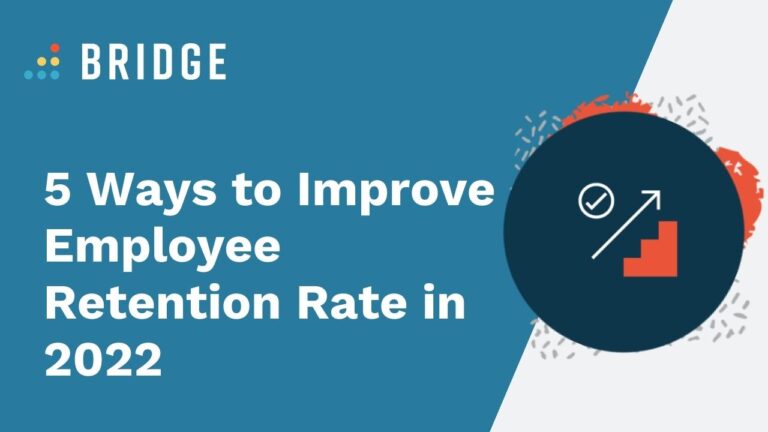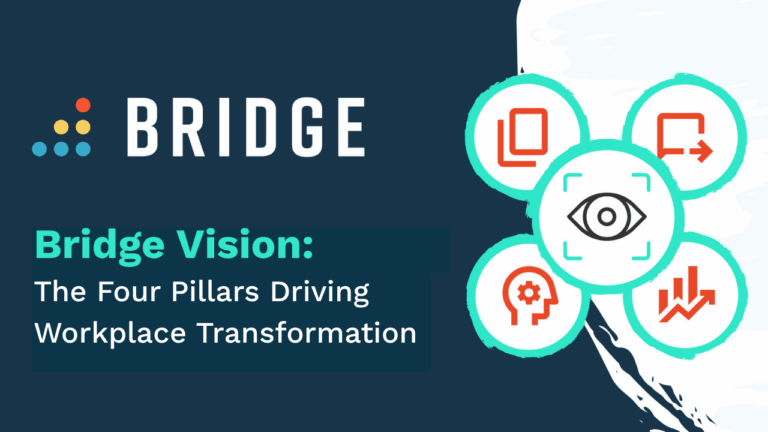What is a good employee retention rate? And why is it important? The answers to these questions plus five ways to improve your retention rate are right here.
With the huge shifts we’ve seen in the world of work in the last two years, it’s never been more important to focus on the people in your organization. Employee retention has been a buzzword/phrase in HR for a long time, but in 2022 it’s starting to mean something a bit different.
Why Is Employee Retention Important?
There are two sides to look at this from—the employee side and the business side.
Firstly, let’s look at the employee side. You need to assess how employees are treated and get an honest reflection of how happy people are in their roles. This starts with open and honest communication because employees who don’t feel comfortable providing negative feedback to their line managers or HR departments won’t explain why they’re unhappy until it’s too late.
It’s more important than ever to prioritize your employees’ needs. And these needs have changed since the onset of the COVID-19 pandemic. More employees have come to realize the importance of flexibility over a period of enforced remote working, and mental health is now at the forefront of conversations about well-being.
From the business side, improving employee retention greatly reduces costs, increases morale, and allows your employees to function better as a team. Unfortunately, employee departures beget more departures. And the same can be said for retention.
Ultimately, happy, respected, and well-paid employees will stand the test of time. While job-hopping becomes the norm in many industries, and the average employee turnover rate in the US rose from 42.6% in 2016 to 57.3% in 2020, there are things you can do to slow this trend down and keep your employees engaged.
So from both a financial business perspective and for the long-term happiness (and productivity) of your people, you need to do your best to keep your retention rate high and your turnover rate low.
RELATED READING | ‘How Connecting With Employees Helps Strengthen Organizational Resilience’
What Is a Good Employee Retention Rate?
Well, it varies drastically between industries and across countries. In the UK, the average employee turnover rate is 15% per year. The highest turnover rates are in sectors like retail, call centers, and construction with lower turnover in professions like legal, accountancy, and the public sector.
However, federal data from the US shows that over 4 million people quit their jobs in January 2022, with over 48 million leaving their jobs in 2021, a new annual record. So it seems this number is likely increasing.
All that said, a turnover rate of less than 15%, especially with the job market as it is now, sets you in good stead. However, it may be worth revisiting these numbers in a year or two as we’re sure to see the average turnover rate changing.
How Much Does Employee Turnover Cost?
According to research from Oxford Economics, back in 2014, the cost of replacing an employee on a salary of £25k or more was in excess of £30k. With the cost of recruitment rising and how competitive the market is, in 2022 the true cost is likely to be higher. In the US, it’s estimated that replacing employee can cost between 30 and 50% of their salary. HubSpot even provides an equation to help you determine the cost of turnover in your specific organization.
So what can you do to reduce turnover?
How to Improve Employee Retention Rates
1) Provide Flexibility
In the post-lockdown world we live in, flexibility is no longer a nice to have. Whether it’s the flexibility to pop out for the school run, cutting down on commuting, or simply having the option to work when and where they like, many of your people are now used to a different way of working.
And chances are that if you didn’t offer that through the pandemic, they will be looking for somewhere that offers it now. It’s not about dictating whether people work from home or work in an office, but providing additional flexibility about working hours and location.
2) Promote a Work-Life Balance
While work-life balance slipped out of the grasp of many employees as working from home became the norm in the last two years, it’s now a joint effort to make sure balance is restored.
It’s important to lead by example and make sure you have enough staff available to get the job done within working hours. And more than that, it’s important to have line managers around who encourage their employees to switch off from work.
That means no sending emails in the early hours of the morning. No messages or calls or meetings of “can you just” at 5 or 6pm when they’re just about to sign off. Company policy and line managers need to play an active role in ensuring work-life balance.
3) Offer Coaching and Mentoring
Another huge part of improving employee retention is actively investing in their progression and development. Coaching and mentoring provide excellent opportunities to help your people feel heard in a judgment-free environment and develop their skills in a way that can benefit both parties.
A key thing here is to focus on your particularly ambitious employees, as they’re the ones most likely to move on. As well as identifying those who would benefit most from coaching and mentoring, it also means paying attention to who is willingly taking on more and more responsibility.
Coaching and mentoring show your employees that you’re invested in their development. This will, in turn, make them feel heard and appreciated. But it’s also important that these schemes aren’t selfish on the part of the business. You need to allow employees to develop in the way they wish to and not constrain them to a particular job role or box.
YOU MIGHT ALSO LIKE | ‘The Race to Reskill: 3 Ways Internal Mobility Can Help Close the Skills Gap’
4) Focus on Training and Development Opportunities
This is a huge part of why so many people leave their jobs. Even if the culture is great, the pay is decent, and they get on well with their line manager(s), if your employees have nowhere to go inside your organization, they’ll find somewhere to go outside of it.
Learning and development is taking a leading role in increasing employee retention. According to LinkedIn’s 2022 Workplace Learning Report, having opportunities to learn and grow is now the top driver of great workplace culture (up from 9th place in 2021). The report also states that 79% of L&D pros agree that it costs a lot less to train and develop existing employees than recruit new ones due to turnover.
A sure-fire way to make an employee feel unappreciated is to make them feel that they must “prove themselves” for a number of months or years before they can begin to try to fight their way up the career ladder or be fairly compensated for their work.
Providing a clear development path within your organization can go a long way to keeping your employees engaged and on side.
5) Create a Culture of Trust and Inclusivity
This may be the most important item on the list. Gone are the days when employees are happy to settle for a job that pays their bills and just stick with it because it’s easier than leaving. Building a culture of trust and inclusivity starts from the top. So what does that actually look like? It’s about having:
- A truly diverse senior leadership team
- Open and honest communication with line managers
- Accommodations made for anyone who needs them
Someone on your team is autistic? No problem—ask them what accommodations they need and stick to them consistently. Another has three kids under the age of 10? Cool. Let them manage their hours around the school run and family time.
A culture of trust and inclusivity impacts so many areas of an employee’s working life, whether it’s not having to ask permission to go to the doctors or feeling comfortable asking for accommodations around life, work environment, and mental health. These things all add up and make a big difference. These are the reasons people stay.
MORE FROM THE BLOG | ‘Putting People First: Why Creating an Employee-First Culture Matters’
How Can Bridge Help?
Want to retain your best people? It starts with developing their skills so they’ll want to grow with you!
Bridge’s Skill & Career Development software helps organizations close the skills gap by uncovering which skills are lacking, delivering impactful learning to improve those skills, and helping employees articulate and achieve their career visions.




